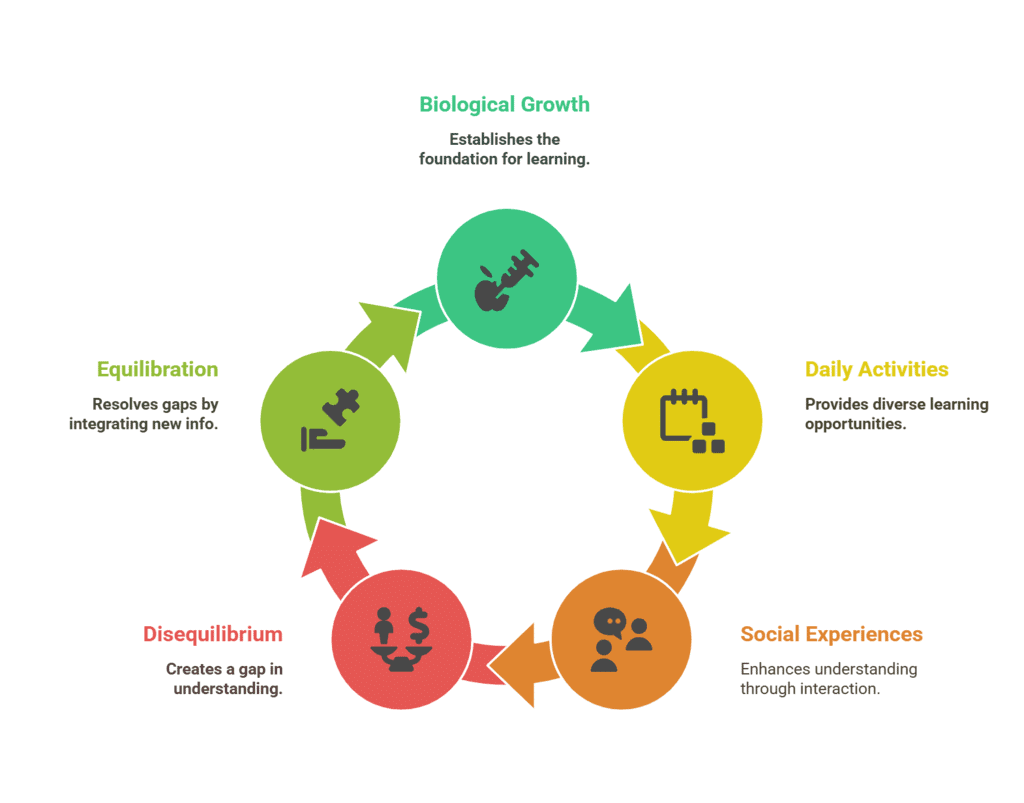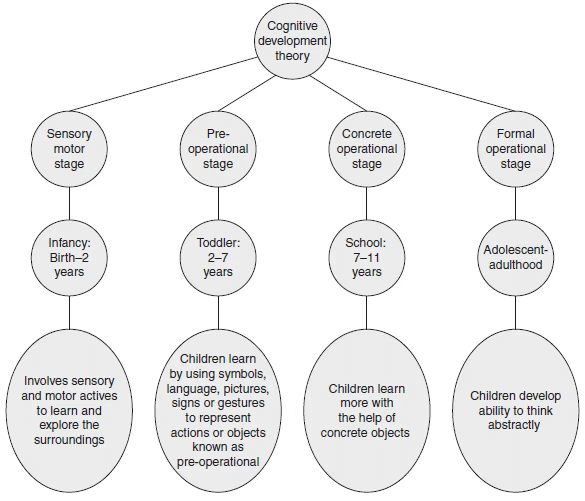Notes: Cognitive Development Theory | Child Development and Pedagogy for CTET Preparation - CTET & State TET PDF Download
Piaget's Theory of Cognitive Development
Jean Piaget, a Swiss psychologist originally trained in zoology, is renowned for his groundbreaking theory of cognitive development in children. His early work with Alfred Binet on intelligence testing ignited his interest in child development, prompting him to delve into cognitive and moral growth. This background in zoology and psychological research provided a strong foundation for his later studies on how children perceive and interact with the world.
Constructivist Approach
Piaget is often considered a radical constructivist, emphasizing that children actively construct their understanding of reality rather than passively absorbing information. He proposed that cognition is an adaptive process, continuously evolving rather than simply mirroring the external world.
Universal Stages vs. Cultural Influence
His theory outlines universal stages of cognitive development, suggesting that all children progress through similar phases of learning. However, one of the key criticisms of Piaget’s work is its limited consideration of cultural factors in cognitive growth, as it focuses primarily on biological and individual aspects of development.
Genetic Epistemology
Piaget’s approach, termed genetic epistemology, explores the origins of knowledge. He argued that the fundamental structures and processes of cognitive development are innate and universal, occurring in all individuals regardless of cultural background. Here, the word "genetic" does not refer to heredity but rather to the idea that these cognitive processes are naturally occurring across all human beings.
Cognitive Development
Cognitive development refers to the process of developing thinking abilities, such as memory, problem-solving, and decision-making, from childhood to adulthood. This development is influenced by both genetic factors and environmental circumstances. It involves various aspects like information processing, intelligence, reasoning, language skills, and memory, encompassing how we perceive, think, and reason about the world around us.
Cognitive Development: Basics of Learning and Cognitive Growth
- Biological Growth: Piaget emphasized the importance of biological growth in learning and development, highlighting the role of heredity.
- Daily Activities: Engaging in different activities such as work, socializing, and educational discussions is crucial for cognitive development.
- Social Experiences: Sharing social experiences helps children grasp the meanings behind their actions, contributing to their understanding.
- Disequilibrium and Equilibration: When there is a mismatch between what a child wants to learn and what they know, it creates disequilibrium. Children strive to resolve this imbalance through equilibration, balancing their understanding with new information.

Conceptual Frameworks and Cognitive Adaptation
- Schemas: Piaget proposed that we organize information in our minds into categories called schemas.
- Adaptation: The process of adapting to the environment involves assimilation and accommodation.
- Assimilation: This is when new information fits into existing schemas. For example, a child recognizing a tricycle as similar to a big wheel.
- Accommodation: This occurs when new information requires modifications to existing schemas or the creation of new ones. For instance, adjusting from a tricycle to a bicycle.
- Disequilibrium:. state of imbalance arises when existing thinking patterns do not suffice to understand a situation, prompting the need for adaptation.
Four Stages of Cognitive Development
Piaget proposed that children progress through four essential stages of cognitive development, each marked by distinct ways of thinking and understanding the world. Here's a detailed look at Piaget's theory and its implications for education.

1. Sensory Motor Stage: (0–2 Years)
- During the sensory motor stage, children are learning about the world through their senses and developing their motor skills.
- Children are constantly exploring their surroundings by seeing, hearing, touching, and moving.
- At this age, children are also learning to control their body movements, which is crucial for their overall development.
- Children learn to identify objects and understand that each one exists independently. They also grasp the concept of object permanence, which means that objects still exist even when not visible.
- As they grow, children engage in goal-directed activities, such as catching a ball or solving simple puzzles. This progression from basic to more complex actions helps them develop logical thinking.
Sub-Stages of the Sensory Motor Stage:
- Stages of Reflex Activities (0–1 month): Inborn reflexes like sucking and looking help the child understand their surroundings.
- Primary Circular Reactions (1–4 months): Children repeat actions that bring them pleasure, such as thumb sucking.
- Secondary Circular Reactions (4–8 months): Children focus on actions that elicit responses, repeating behaviours like putting objects in their mouths.
- Coordination of Reactions (8–12 months): Children begin distinguishing between means and goals, generalising their learning to different situations.
- Tertiary Circular Reactions (12–18 months): This stage involves exploration through trial and error, allowing children to gain confidence and understanding of their environment.
- Early Representational Thought (18–24 months): Children start engaging in mental activities and demonstrate an understanding of object permanence.
2. Pre-Operational Stage: (2–7 Years)
- In the pre-operational stage, children's thinking is still developing, and they are not yet capable of performing logical operations.
- This stage is divided into two parts: the pre-conceptual stage (2–4 years) and the intuitive stage (4–7 years).
- During this stage, children begin to process thoughts more actively, but their thinking is not as efficient as that of adults. They start to expand their vocabulary and exhibit behaviours that are more similar to those of adults.
- One of the key characteristics of this stage is ego-centrism, where children tend to focus on their own perspective, assuming that others share the same viewpoint. As they grow, they gradually learn to consider multiple perspectives, a process known as decentring.
- Animism is another aspect of their thinking during this stage. Children believe that inanimate objects have feelings and emotions. For example, they might think that a table feels pain when it is hit.
- Children also develop the ability to use symbols, language, and gestures to represent objects and actions. Piaget referred to this ability as the semiotic function.
- Despite these advancements, children at this stage often struggle with understanding moral realism, which leads to a strong respect for rules and authority. They tend to focus on one aspect of a situation at a time and may have difficulty grasping more complex concepts.
Educational Implications of the Preoperational Stage:
- Instructions should be brief and include actions.
- Students need breaks between instructions.
- Visual aids are essential for teaching.
- Teachers must recognise that each student may understand concepts differently.
- Practical experiences engage learners in the teaching process.
- The play-way method is most effective for this age group.
- Hands-on activities enhance cognitive development, allowing exploration with toys, sand, and water.
- Children should connect their experiences with the concepts being taught.
At this stage, children cannot perform reversible thinking. While they can manage simple logical tasks, they struggle with concepts like reverse counting and conservation. Conservation means that some properties of an object remain unchanged despite changes in appearance. For instance, children may think a taller glass holds more water than a shorter one, despite them having the same volume. This indicates that their thinking is often one-dimensional.
Children at this stage are pre-scholars enrolled in play schools. Observations indicate they engage in a unique form of speech, known as collective monologues, where they talk in groups but do not engage with others. This behaviour results from ego-centrism and a lack of decentring.
3. Concrete Operational Stage: (7–11 Years)
- In the concrete operational stage, children gain the ability to perform operations on concrete objects and situations.
- Unlike the pre-operational stage, where thinking is limited to specific instances, children in this stage can apply logical reasoning to tangible problems.
- However, their understanding of abstract concepts and ideas that require mental conjecture is still developing.
- This stage marks a significant advancement in cognitive abilities, as children become more adept at manipulating objects and understanding the relationships between them.
- For example, they can grasp concepts like conservation, where they understand that the quantity of an object remains the same despite changes in its appearance, such as in the case of liquid poured from one container to another.
- While children in the concrete operational stage can think logically when dealing with physical objects, their ability to engage in abstract thinking, as seen in the formal operational stage, is not yet fully developed.
4. Formal Operational Stage: (11 Years – Adulthood)

In the formal operational stage, which begins around 11 years of age and continues into adulthood, children develop the capacity for abstract thought. They move beyond concrete thinking and can understand complex ideas involving numbers, variables, and abstract concepts. This stage is characterized by the ability to create logical systems, consider multiple solutions to problems, and connect different variables.
Children in this stage use a problem-solving strategy known as formal operations. This involves identifying all factors that could influence a problem and systematically deducing solutions. This approach, called hypothetico-deductive reasoning, allows adolescents to think beyond immediate reality and explore a range of possibilities. However, there is a risk of getting lost in abstraction and neglecting practical realities.
Piaget suggests that as children enter this stage, they become less egocentric. However, they may still believe that others share their thoughts and feelings, leading to a form of adolescent egocentrism. This is characterized by a heightened self-consciousness, where individuals feel they are constantly being observed by others. For example, teenagers may spend a lot of time in front of a mirror, concerned about their appearance to others.
Educational Implications of the Formal Operational Stage:
- Encourage Hypothetical Reasoning: Provide students with abstract problems that require hypothetical reasoning to solve.
- Foster Imagination and Creativity: Assign tasks that encourage imaginative thinking and creative problem-solving.
- Promote Concept Exploration: Create opportunities for learners to explore concepts beyond rote memorization of facts.
- Balance Abstract and Concrete Learning: While developing abstract reasoning skills, continue to use concrete objects and experiences in teaching.
- Encourage Inquiry: Motivate students to formulate their own questions and seek answers independently.
- Facilitate Scientific Discussions: Organize discussions aimed at scientifically addressing and solving problems.
|
67 videos|154 docs|41 tests
|
FAQs on Notes: Cognitive Development Theory - Child Development and Pedagogy for CTET Preparation - CTET & State TET
| 1. What is Piaget's Theory of Cognitive Development? |  |
| 2. What are the four stages of Piaget's Theory of Cognitive Development? |  |
| 3. How does Piaget's Theory of Cognitive Development explain the development of children's thinking? |  |
| 4. What is the significance of Piaget's Theory of Cognitive Development in education? |  |
| 5. How can Piaget's Theory of Cognitive Development be applied in the classroom? |  |






















